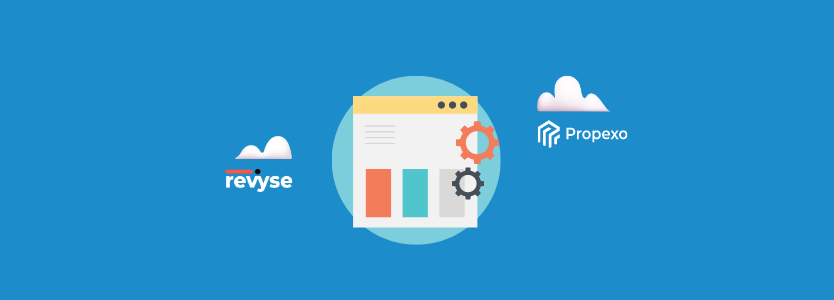Websites | Revyse Tech Buyer's Guide
As a multifamily decision-maker, selecting the right website technology vendor and implementing a new platform is a critical task with long-lasting consequences. The right choices can truly revolutionize your marketing and improve the prospect experience.
The multifamily industry is evolving at a rapid pace, with best-in-class website technologies and CMS platforms accelerating the leasing process and creating new opportunities for portfolio growth. These solutions can significantly enhance efficiency and boost profitability for any size operator, however, exploring a new website vendor can be challenging - even for the most experienced multifamily professionals.
The good news is that the B2B software buying landscape has changed, putting multifamily software buyers in the driver's seat like never before. Self-service demos, access to product reviews, and transparent vendor and supplier data are just a few of the tools that empower operators to navigate the website vendor selection process with confidence.
In this guide, we'll walk you through the key considerations when selecting a new website platform or CMS for the multifamily industry. From understanding your requirements to evaluating features and assessing vendors, this guide aims to help you make an informed decision that aligns with your portfolio goals, so that you can build an ideal marketing tech stack.
Where to Start : Define Your Requirements
A well-thought-out business case and clearly written requirements can make all the difference in ensuring that your next website vendor evaluation is thorough - and successful. Understanding and defining your requirements for a new solution ahead of time is the foundation of every good decision when it comes to buying new tech.
💡 Deep Dive Into Requirements: For a deeper dive into the concept of requirements, what they are, and how to write them, take a look at this article, Multifamily Software Buying 101: Nailing Requirements.
By identifying the specific requirements you have for your new website platform, and then writing them down, you can narrow down your search and focus on solutions that cater to your use case.
Remember, not all requirements carry equal weight. Pinpoint the most critical ones and rank them based on their significance to your company and your objectives. If there are some requirements that are non-negotiable, put those at the top. If there are others where you can be flexible, move them toward the bottom of your list.
Now, let’s take a look at a few real-world examples of potential requirements for multifamily websites, and how they could help you make a more informed decision when selecting a new marketing vendor.
Example Requirements:
✅ - The vendor should be able to honor our request to un-publish a community website within 72 hours of notice to dispo.
Do you acquire and dispose of properties frequently? You should understand how quickly a vendor’s customer support team will respond to your requests to create new sites or remove old ones. You may determine that your team needs to have self-service access to edit the CMS themselves. If you have a long-hold strategy, this requirement may not be relevant to your business model.
✅ - The platform should support the use of our owned Google Analytics account.
How do you track your website performance KPIs today? If you’re using a tool like Google Analytics, you’ll want to ask if you can continue using the same GA account, and how the vendor can support your tracking and analytics needs within that same analytics framework.
✅ - Our new websites need to be live by November 15th.
Do you have a specific deadline that you need to meet? Website implementation timelines can vary wildly. Start to finish, a full-portfolio build can take anywhere from 90 days to 9 months with a full-service templated website vendor, while branding agencies and custom development shops may quote somewhere between 5-12 months for a custom build. Conversely, a single website for a new development or recent acquisition should be much quicker, about 2-3 months on average.
✅ - We want to work with a vendor who will lead the brand direction and creative on our behalf.
Before kicking off your search, it’s important to understand how much control your team wants to have over the look and feel of your new website, or if you will be leaning on an expert to develop the brand. Directing the creative on a website project is a huge amount of work, so before signing up to lead the brand direction for your next project, be sure that you have the resources available (both headcount and time) for the entire length of the project. If you know resources are tight, look for a multifamily vendor who can lead the brand design as well as the technical build.
✅ - We want to own our own website.
Is it important that your company ‘owns’ the website and has complete ownership or control of that digital asset? When evaluating vendors, be sure to ask whether your investment in the design will be limited to their system, or if the website is capable of continuing to operate in the event that your relationship with the vendor were to end. This may be important to understand in the event of a property disposition.
Establishing the requirements for your vendor evaluation and writing them down ahead of time will help you stay focused during the research process.
Researching Multifamily Website Vendors
With your requirements in mind, it's time to research the options available in the market and find a few potential website platforms that can address your company’s needs head on.
The multifamily industry is nuanced, so when you’re researching, look for vendors that have specific industry experience and positive customer feedback from multifamily companies that share a similar size, investment strategy, submarket, or area of focus as you do.
Here are a few good places to start:
Explore industry-specific product review sites and publications.
Leverage search engines and visit vendor websites.
Look for case studies and customer testimonials to leverage the experiences of other operators who have used the website platforms you are considering.
Reach out to peers, colleagues, or industry experts for their insights and suggestions on the best solutions to address your needs.
Online forums, communities, and professional associations can also be valuable sources of information about website vendors.
Keep a record of the website vendors and products that catch your attention, as you'll dive deeper into evaluating them in the next sections.
Product Demos
Once you’ve developed a short-list of potential website vendors and platforms, it's time for product demos. A product demo gives you first-hand experience of how the website platform or CMS works and helps you determine if it meets your needs.
Not only is it valuable to see the actual user interface (UI) and get a glimpse of how the website technology works, product demos often walk you through specific industry use cases, so you can see how different build options could be leveraged in your marketing strategy.
More and more vendors are embracing modern sales practices and offering transparent, self-service product demos, which allow buyers like yourself to tour their website or CMS platforms on your own, at a time that is convenient for you, and without the need for a sales rep. Vendor discovery platforms like revyse.com also host self-service product demos and walkthroughs, so you can easily search by product name or category to find website vendors that offer self-service demos ahead of time.
💡 Hassle-Free Demos: Prioritize vendors that offer transparent pricing and hassle-free access to demos or examples of their work in the real-world, letting you evaluate options without the sales pitch pressure. You’ll be able to take an objective approach, choosing what works best for your business needs, and won’t feel obligated to continue unproductive conversations out of kindness.
If the vendor doesn't have a self-serve product demo available online, you can usually still contact them directly to schedule a demo with a sales rep.
It may take more than one sales call to get access to a resource who can answer your technical questions about functionality and integrations (usually called a Sales Engineer or a Solutions Architect), but being upfront with the sales rep about your intent to gather technical info can help you navigate the sales process more quickly.
Evaluating Key Features
Demos are the ideal time to evaluate each potential website platform’s key features. Before you start the self-service demo or join the sales meeting, be sure to grab your list of requirements for your new website. As you walk through the platform, compare the features and functionality against your requirements, and take notes. And most importantly, be transparent with the vendor about each of your requirements and make sure they understand your needs up front.
💡 Create a Checklist: During the evaluation process, create a checklist or a simple comparison table in Excel to assess each potential website platform side-by-side, based on your requirements.
During the demo, look for solutions that not only address your immediate pain points, but also offer flexibility for future growth or changes in how your company operates. For example, if you acquire another property in the next month or two, would that vendor also be a good fit for another website build project?
When you’re researching and demoing solutions with today’s modern multifamily website platforms and agencies, some capabilities to keep an eye out for are:
☝️ Flexible Domain Strategies - If you operate your website using a single-domain strategy, where your community websites are nested under your corporate domain to provide an ILS-like experience to prospective renters, you’ll want to ensure that you can maintain that competitive advantage when choosing a new vendor. If you’re managing each community’s website on its own independent standalone domain, you’ll want to ask about domain management and user management, to keep track of log-ins to each website.
Questions to ask:
Does your platform support single domain or multi domain strategies?
Do you require each community to have a standalone domain and website?
Would my existing prospect or resident portal be compatible with that set-up?
✌️ Templates vs Custom Builds: If having a differentiated look and feel to your website is important, you’ll want to ask about custom designs, or at the very least, customization of an existing template to produce a more distinctive look. Customizations are usually more time intensive (for a better end result), so be sure to factor that into your overall timeline.
Questions to ask:
Is each website custom built for the property or asset, or do you provide pre-designed templates for us to choose from?
If you use templates, can they be customized to our specific needs?
How can we make sure that our website won’t look dated in 2 years? Are redesigns included?
Chris Arnold, Co-Founder of digital design firm Authentic Form & Function, suggests considering custom brand-forward website designs for those communities or assets that need the extra mile, like new developments and properties in lease-up.
"To make a deeper impact and boost leasing velocity, consider a brand-forward website experience that skips the template look."
🤟 Pricing and Availability Data: If displaying accurate unit pricing & availability directly from your PMS or CRM system is important to you, be sure to ask about how the website platform supports this data early on in the discovery process. Accurate unit merchandising is a critical component of delivering a great prospect experience on your new website.
Questions to ask:
Tell me about your integrations with our PMS/CRM provider.
How do you pull pricing and availability data?
Will the floor plans show pricing as ‘starting at’ values or as ranges?
Can you include our required legal disclaimers around quoted pricing?
✌️✌️ Supported Tech Stack: Do you use additional technologies to augment your prospect experience, such as chatbots, interactive maps, video touring platforms, or dynamic number insertion (DNI)? If you plan to continue using these tools, then you’ll want to be sure that your new website vendor can support your existing tech stack. In some instances, a new vendor may have a different solution, or better yet, native functionality that could replace the need for a separate product.
Questions to ask:
Can you tell me more about your view on industry partnerships?
How does your platform handle third-party integrations, such as CRM systems or virtual touring and interactive maps?
Does your platform support the use of a broad range of best-in-class point solutions, or would you require us to use your specific product set?
Grady Newman, Founder of multifamily marketing platform Resi, recommends digging deep into the vendor’s product roadmap as a critical evaluation step during your vendor research process.
"Ask about direction of the company and their product roadmap. It should be well thought out and align with the vision you have for your company and the industry as a whole."
Double-Click on Technical Functionality
As a multifamily marketing leader, you have a ton on your plate - leaving limited time to focus on becoming a technical authority in website performance. But don’t worry, we’ve got you covered!
👉 Here is a list of technical questions to get you started during your vendor evaluation:
How does your platform address responsiveness and ensure usability on mobile devices?
Can you explain your approach to image compression and caching and how it impacts page load speeds?
Is standard SEO schema integrated into each website by default?
Do your templates comply with a specific WCAG accessibility level? Is this achieved through native functionality or an add-on widget?
What measures do you have in place to ensure website security and protect against potential vulnerabilities?
How does your platform handle website performance optimization, such as code minification and browser caching?
Can you provide details about the content management system (CMS) used and its capabilities for managing multifamily websites?
Are your websites designed to be scalable and handle high volumes of traffic without performance degradation?
What analytics and reporting features are available to track website performance and user behavior?
Understanding the Impact of Integrations
One area of the technology selection process that is often overlooked is integrations. Ensuring that the multifamily website platform you're considering can easily integrate with your critical software systems and operational processes is crucial to avoid disruptions, data silos, and to maximize the benefits of the new solution.
The most common integrations that multifamily professionals look for are integrations with core property management tools, such as accounting software, property management systems, and CRMs.
It’s important to remember that not all integrations are created equal. The level at which a product may be integrated with one of your company’s core systems can vary from vendor to vendor.
When it comes to integrating a website with your property management system or CRM, it's important to understand the difference between common integration types.
🪝 Webhook
A webhook is a way for one system to provide notifications or data to another system. It is essentially a callback mechanism.
When an event or trigger occurs in one system, it notifies the other of the event.
Webhooks are typically used for one-way communication, where the system that receives the webhook data may perform specific actions but does not usually send data back to the original system.
📲 One-Way Integration
In a one-way integration, data flows in a single direction, meaning that information from one system can be pushed to the other.
However, any updates or changes made within the ‘receiving’ system won’t be reflected in the ‘sending’ system.
One-way integrations are often used when the website serves as a marketing tool to showcase property details and generate leads, while a separate system handles leasing.
👀 Bi-Directional Integrations
A bi-directional integration refers to a system-to-system connection where data is synchronized and shared in both directions.
Typically, updates such as availability changes or new lease signings, can be automatically reflected on the website, and similarly, inquiries, leads, and application submissions from the website can be seamlessly transferred to the receiving system for further processing and management.
Bi-directional integrations provide a more comprehensive and real-time view of property information, ensuring consistency between systems.
In addition, it’s important to note that different data sets within the same system may be integrated using different methods or mechanisms, and just because one data set is integrated a certain way, it doesn’t mean all of the data will follow that pattern. For one provider, pricing and availability may be shared using a one-way integration, while lead submissions may use a webhook.
Integrations can be complex, so spend some time understanding how a potential vendor views the multifamily industry’s vendor ecosystem and be sure to choose a partner who shares the same philosophy as you do regarding data ownership and system compatibility.
Assessing Vendor Reputation
In addition to evaluating a website platform’s features, it's crucial to assess the reputation and credibility of the vendors behind the solutions.
Consider vendors with a solid track record in serving the multifamily industry. Look for testimonials or case studies highlighting their success stories in multifamily apartment websites, and read user reviews to understand how their websites perform in the real world.
💡 Leveraging Peer Reviews: Vendor reviews are your secret weapon in the software shopping battle, saving you from unpleasant surprises down the road. Revyse lets you quickly understand how a new solution would fit into your existing tech stack by reading authentic reviews from industry users who have gone through implementation themselves.
Check out software review sites like TrustRadius and G2 when shopping for generic solutions like Wordpress or Drupal, or leverage the Revyse community for access to industry-specific user reviews for multifamily website vendors and design agencies.
By choosing a reputable vendor, you can have confidence in the long-term reliability and support of your new website.
Pilots and Trial Periods
Consider taking advantage of any trial periods or pilot programs offered by vendors when shopping for a new platform.
Trial periods are typically free, and will give you hands-on experience with the platform and a deeper understanding of its functionality and user-friendliness.
Pilot programs will help you measure the quantifiable impact of the platform on property performance, without the commitment of a full portfolio implementation project. Pilot programs can be free or paid, and typically involve testing the live product for 90+ days on 3-5 active properties in your portfolio. The purpose of a pilot is to gather data on performance.
During pilots or trial periods, be sure to involve relevant team members and end-users who will be working with your websites on a daily basis. Gather their feedback and assess how well the platform aligns with their specific workflows, and make note of any new requirements that might surface.
Keep in mind that vendors offering fully-custom website builds or unique design + branding packages won’t be able to offer free trials, but that shouldn’t deter you from exploring those solutions that are customized to your company’s specific needs. Custom builds can be a great way to level up your resident experience.
Considering Implementation and Support
Understanding product implementation and onboarding processes ahead of time can save you endless heartache and hours of tedious manual work, protecting your team from the dreaded “onboarding spreadsheet.”
Be sure to ask the vendor what to expect during implementation and onboarding, such as:
Implementation timelines
Onboarding processes
Building any custom integrations
Property information transfer
Training resources
Ongoing customer support
Ticketing systems or portals
On-demand knowledge bases
Each of these areas can have a significant impact on the successful implementation of a new website, and can influence how well a new vendor partner is received by both corporate and onsite teams.
💡 Ongoing Support Costs: Another critical aspect of choosing a website provider is understanding the cost of ongoing support, including changes, edits, or updates to your website. This is often overlooked when comparing pricing, and can have a significant impact on the overall investment required to maintain your new site.
Making the Final Decision
Now, it's decision time. Put on your analyst hat and weigh each proposal and demo against your prioritized requirements. Think about factors like cost, the time it'll take to get the ball rolling, ongoing support, and any design customizations or integration requirements you might have for your new website.
And finally, take a deep breath and make your choice. Trust your research, your peers, and your instincts to select the perfect multifamily website provider for your next project.
Happy software shopping!
⭐ ⭐ ⭐ ⭐ ⭐
Team Revyse
.png)
Team Revyse





































